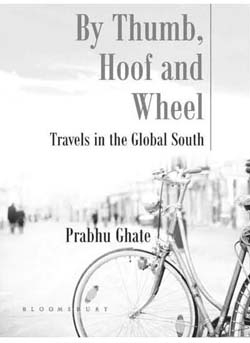‘It is good to have an end to journey toward; but it is the journey that matters, in the end. (Ernest Hemingway)
The opening sentence of Prabhu Ghate’s By Thumb, Hoof and Wheel: Travels in the Global South sets the tone for what the traveller-reader should expect from the book: ‘Apart from trying to communicate the sheer joy of travel, and its huge educational possibilities, and weaving a bit of contemporary history into the story, I hope to persuade readers in this book that one does not have to be particularly rich to travel, or young for that matter (just young at heart, reasonably fit, empathetic, and curious.)’ The book catches the fervour of our times, when interest in travel and travel writings is growing among people, especially catching on with Indians.
Today numerous blogs offer itineraries not only about well-known places but even off-beat ones and those related to adventure sports like rafting and trekking, and the sales figures of Roy and Jha’s Heat and Dust Project: The Broke Couple’s Guide to Bharat testify to the popularity of the genre. Ghate’s book does not claim to be a Lonely Planet or Outlook Traveller that gives detailed information about a place but a personal recounting of the writer’s travels, a selective narration from the hundred-odd countries that he has visited. The book is divided into seven chapters along with an introduction and a select bibliography. It also carries maps of several journeys like the ‘Gringo Trail’ and ‘Horn of Africa’, and the coloured photographs add to the visual appeal of the book, supplementing the written word. Out of the seven trips described, those to the Philippines and China are single country journeys while the rest are multi-country trips. The trips are described in the order in which they were undertaken in the South with the exception of the first one set in the North.
Even as the book attempts to push people out of their arm chairs, it will largely appeal to travellers, where most will agree that a serious traveller ventures out alone. Ghate quotes from Paul Theroux’s The Tao of Travel to make a case for it as a solitary enterprise, ‘It is hard to see clearly or to think straight in the company of other people. What is required is the lucidity of loneliness to capture that vision, which however banal, seems in your private mood to be special and worthy of interest.’ Some travels that he describes are no longer possible like taking a paddle steamer up the Nile; visiting Yemen has security concerns.
Ghate writes that travel is about search for authenticity. ‘This book is as much about travelling in a manner that helps in the search for authenticity, as it is a possible source of travel ideas.’ And the book suggests new travel itineraries and gives interesting leads like capitalizing on airline stopovers for unusual experiences like Addis Ababa of Ethiopian Airlines. It offers tips on cheaper ways to travel like hitch hiking; staying at gurudwaras and police stations in East Africa; using Alaskan state government ferry to break journey without any accompanying penalty; and taking night buses to save on hotel rent. It is targeted at an audience for whom travel is a priority over upgrading a car and insufficient funds is not an excuse to give up their air chairs. The book is interlaced with textual references from other writers like V.S. Naipaul, Vikram Seth and William Darlymple to substantiate writings on particular regions and experiences.

